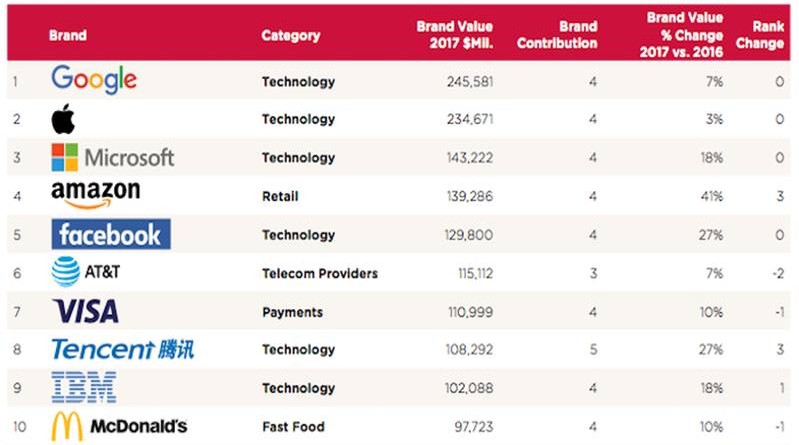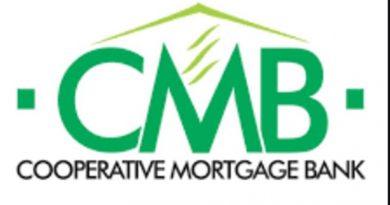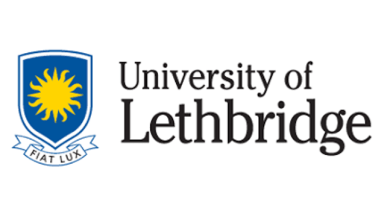The World’s Most Valuable Brands 2018 and there is no African or South American brand on the list
No African, Russian, Indian, South American or Australian brand is in the top 100 Brands of the world for 2018. American brands dominate with over 54 spots on the list including the first 6 spots while Germany follows with 14 spots. In the same vein Tech brands lead with 20 spots while Financial Services follow with 13 spots. McDonalds, Starbucks and KFC, the leading fast food companies in the World also made it on the list occupying spots 11, 34 and 100 respectively. The UK has just one spot on the list.
Apple tops Forbes’ annual look at the world’s most valuable brands for the eighth straight year. The brand of the tech titan is worth $182.8 billion by Forbes’ count, up 8% over last year. Apple is worth 38% more than second-ranked Google ($132.1 billion), although the gap in brand value between the Silicon Valley giants was three greater in percentage terms just three years ago ($145.3 billion vs. $65.6 billion).
Google is gaining steam, but Apple remains the gold standard for its ability to generate massive profits through premium pricing and insatiable demand for its products around the globe.
Forbes evaluated more than 200 global brands to determine the final list of the 100 most valuable. Brands were required to have a presence in the U.S., which knocked out some big brands like China’s Alibaba and Tencent. If this rule is removed, then Shenzhen-based Tencent (TCEHY) with a brand value of $179 billion will hold fifth place — behind Google, Apple, Amazon (AMZN) and Microsoft (MSFT) but above Facebook (FB) and at No. 9 will be Jack Ma’s Alibaba which has seen its brand value nearly double to $113 billion as the e-commerce company has expanded further into fields such as mobile payments and cloud computing.
The top 100 includes product brands like Proctor & Gamble’s Gillette, as well as brands marketed under their corporate name like American Express.
Forbes values brands on their financial merits instead of consumer surveys. Below is a breakdown of the top 100 brands by country, industry, gainers and more.
Cumulative value for top 100 brands: $2.15 trillion, up 10%.
Top Brands By Country:
U.S. (54 brands), Germany (12), France, Japan (7), Switzerland (4), Belgium, Korea, Netherlands, Spain, Sweden (2 each), Austria, Canada, China, Denmark, Ireland, U.K. (1)
Top Brands By Industry:
Tech (20), Fin Serv (13), Automotive (12), Consumer Packaged Goods (11), Retail (9), Luxury (6), Diversified (4), Alcohol, Apparel, Beverages, Restaurants, Telecom, Transportation (3), Leisure, Media (2), Aerospace, Business Services, Tobacco (1)
Bigger Gainers:
Netflix (35%), PayPal (33%), Amazon (31%), Google (30%), Facebook (29%)
Biggest Declines:
Gillette (-11%), H&M (-8%), ESPN (-8%), HP (-6%), American Express (-6%)
New Entries In Top 100 vs. 2017:
Volkswagen (#90), RBC (#94), Uniqlo (#96), PayPal (#98), Dell (#99), KFC (#100)
Drop-offs (2017 rank displayed):
BBVA (#80), Caterpillar (#82), Target (#89), Subway (#92), Hershey (#94), Coach (#99)
The 2018 World’s most valuable 100 BRANDS table
| Rank | Brand | Brand Value | Brand Revenue | Industry | Rank | Brand | Brand Value | Brand Revenue | Industry |
| #1 | Apple | $182.8 B | $228.6 B | Tech | #51 | J.P. Morgan | $11.9 B | $47.4 B | Fin Serv |
| #2 | $132.1 B | $97.2 B | Tech | #52 | HSBC | $11.9 B | $76.6 B | Fin Serv | |
| #3 | Microsoft | $104.9 B | $98.4 B | Tech | #53 | Nestle | $11.7 B | $8.6 B | Consumer |
| #4 | $94.8 B | $35.7 B | Tech | #54 | Fox | $11.7 B | $16.3 B | Media | |
| #5 | Amazon | $70.9 B | $169.3 B | Tech | #55 | Netflix | $11.5 B | $11.7 B | Tech |
| #6 | Coca-Cola | $57.3 B | $23.4 B | Beverages | #56 | Chevrolet | $11.5 B | $81 B | Auto |
| #7 | Samsung | $47.6 B | $203.4 B | Tech | #57 | Pampers | $11.4 B | $8.5 B | Consumer |
| #8 | Disney | $47.5 B | $30.4 B | Leisure | #58 | Porsche | $11 B | $25.5 B | Auto |
| #9 | Toyota | $44.7 B | $176.4 B | Automotive | #59 | Cartier | $10.6 B | $6.3 B | Luxury |
| #10 | AT&T | $41.9 B | $160.5 B | Telecom | #60 | Bank of Amica | $10.4 B | $81.7 B | Fin Serv |
| #11 | McDonald’s | $41.4 B | $90.9 B | Restaurants | #61 | Red Bull | $10.4 B | $6.8 B | Beverage |
| #12 | GE | $37.2 B | $104.9 B | Diversified | #62 | Ebay | $10.3 B | $8.6 B | Tech |
| #13 | Mercedes-Bz | $34.4 B | $116.9 B | Automotive | #63 | Sony | $10.2 B | $62.8 B | Tech |
| #14 | Intel | $34.1 B | $62.8 B | Tech | #64 | Chase | $10.2 B | $55.1 B | Fin Serv |
| #15 | Louis Vuitton | $33.6 B | $12.9 B | Luxury | #65 | Citi | $10.1 B | $88 B | Fin Serv |
| #16 | Cisco | $32.4 B | $48.1 B | Tech | #66 | Colgate | $10 B | $5.3 B | Consumer |
| #17 | IBM | $32.1 B | $79.1 B | Tech | #67 | Danone | $10 B | $10.6 B | Consumer |
| #18 | NIKE | $32 B | $33.3 B | Apparel | #68 | Adidas | $9.5 B | $20.6 B | Apparel |
| #19 | Verizon | $31.4 B | $126 B | Telecom | #69 | Lexus | $9.5 B | $20.7 B | Auto |
| #20 | BMW | $31.4 B | $86.8 B | Automotive | #70 | Nissan | $9.4 B | $95.2 B | Auto |
| #21 | Oracle | $30.8 B | $39.5 B | Tech | #71 | Rolex | $9.3 B | $4.6 B | Luxury |
| #22 | Marlboro | $26.6 B | – | Tobacco | #72 | T-Mobile | $9 B | $38.7 B | Telecom |
| #23 | SAP | $26.2 B | $25.4 B | Tech | #73 | Kraft | $8.8 B | $6.5 B | Consumer |
| #24 | Honda | $25.5 B | $120.4 B | Automotive | #74 | Corona | $8.8 B | $5.7 B | Alcohol |
| #25 | Budweiser | $25.5 B | $11.6 B | Alcohol | #75 | Hyundai | $8.7 B | $81.8 B | Auto |
| #26 | Walmart | $24.9 B | $335.5 B | Retail | #76 | Santander | $8.7 B | $49.5 B | Fin Serv |
| #27 | Visa | $24.5 B | $18.4 B | Fin Serv | #77 | BASF | $8.6 B | $69.9 B | Divers |
| #28 | American Exp | $23.1 B | $35.6 B | Fin Serv | #78 | Lowe’s | $8.5 B | $68.6 B | Retail |
| #29 | Pepsi | $18.4 B | $9.7 B | Beverages | #79 | Huawei | $8.4 B | $85.9 B | Tech |
| #30 | L’Oréal | $17.2 B | $10.1 B | Consumer | #80 | Adobe | $8.3 B | $7.3 B | Tech |
| #31 | Nescafe | $17.1 B | $9.1 B | Beverages | #81 | FedEx | $8.3 B | $63.9 B | Transp |
| #32 | Gillette | $17.1 B | $6.6 B | Consumer | #82 | Heineken | $8.2 B | $5.6 B | Alcohol |
| #33 | Home Depot | $16.4 B | $100.9 B | Retail | #83 | Goldman S | $8.2 B | $42.3 B | Fin Serv |
| #34 | Starbucks | $16.2 B | $21.9 B | Restaurant | #84 | Kellogg’s | $8.2 B | $5.8 B | Consumer |
| #35 | Hermès | $15.3 B | $6 B | Luxury | #85 | Boeing | $8.1 B | $93.4 B | Aero |
| #36 | Gucci | $14.9 B | $6.7 B | Luxury | #86 | Costco | $8 B | $136 B | Retail |
| #37 | Audi | $14.8 B | $59.1 B | Auto | #87 | Chanel | $8 B | $5.6 B | Luxury |
| #38 | Accenture | $14.8 B | $39.1 B | B/Services | #88 | Lancome | $8 B | $5.3 B | Consumer |
| #39 | ESPN | $14.6 B | $11.4 B | Media | #89 | Nivea | $7.9 B | $4.7 B | Consumer |
| #40 | IKEA | $14.5 B | $39.3 B | Retail | #90 | Volkswagen | $7.9 B | $99.6 B | Auto |
| #41 | Frito-Lay | $14.4 B | $11.4 B | Consumer | #91 | LEGO | $8.6 B | $5.1 B | Leisure |
| #42 | Ford | $14.1 B | $149.3 B | Auto | #92 | Panasonic | $7.8 B | $68.4 B | Tech |
| #43 | Wells Fargo | $13.5 B | $97.7 B | Fin Serv | #93 | Philips | $7.7 B | $26.8 B | Divers |
| #44 | UPS | $13.3 B | $65.9 B | Transp | #94 | RBC | $7.7 B | $37.4 B | Fin Serv |
| #45 | CVS | $13.2 B | $184.8 B | Retail | #95 | Allianz | $7.6 B | $118.7 B | Fin Serv |
| #46 | Zara | $13 B | $18.9 B | Retail | #96 | Uniqlo | $7.5 B | $13 B | Apparel |
| #47 | H&M | $13 B | $22.5 B | Retail | #97 | Walgreens | $7.5 B | $84.7 B | Retail |
| #48 | Siemens | $12.8 B | $90 B | Divers | #98 | PayPal | $7.5 B | $13.1 B | Tech |
| #49 | Mastercard | $12.4 B | $12.5 B | Fin Serv | #99 | Dell | $7.5 B | $76.8 B | Tech |
| #50 | HP | $12.4 B | $80.9 B | Tech | #100 | KFC | $7.4 B | $24.5 B | Restaurant |
Methodology: How the Brands were chosen
It began with a universe of more than 200 global brands. Forbes required brands to have more than a token presence in the U.S., which eliminated some big brands like multinational telecom firm Vodafone and Chinese e-commerce giant Alibaba.
Forbes’ first step in valuing the brands was to determine revenue and earnings before interest and taxes for each brand. Data was gathered these from company reports, Wall Street research and industry experts. A tip of the cap to Euromonitor, who provided retail sales figures for certain product brands. Forbes averaged earnings before interest and taxes (EBIT) over the past three years and subtracted from earnings a charge of 8% of the brand’s capital employed, figuring a generic brand should be able to earn at least 8% on this capital.
Forbes applied the maximum 2017 corporate tax rate in the parent company’s home country to that net earnings figure based on tax tables from KPMG. Next, a percentage of those earnings were allocated to the brand based on the role brands play in each industry. (Brands are crucial when it comes to beverages and luxury goods, but less so with airlines and oil, when price and convenience are more important.)
To this net brand earnings number, Forbes applied the average price-to-earnings multiple over the past three years to arrive at the final brand value. For privately held outfits, they applied an earnings multiple for a comparable public company. Brands are all in U.S. dollars and converted at exchange rates from May 14.
From Forbes Magazine, www.forbes.com




